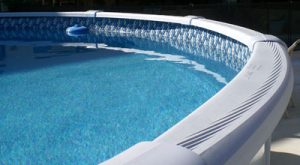With traditional above-ground swimming pools in Orlando, rust can be one of the biggest concerns. Some rust is really no big deal while other rust means the end of the pool.
When is rust a concern? When is it no big deal? Hopefully, this article will help answer some questions.
METAL-WALLED ABOVE-GROUND POOLS ARE MADE OF STEEL, ALUMINUM, OR RESIN PARTS
Also called “hard-sided” AG pools come in all different variations of what parts are made of what. An above-ground pool has a wall, frame, and vinyl liner.
99 percent of the time, the wall of the pool is made of either steel or aluminum. Both will corrode (Steel makes a rust color, while aluminum pits away in small white circles)
The frame of the pool can be made of either steel, aluminum, resin, and usually a combination of a couple of those.
Only parts made of steel or aluminum will corrode.
PARTS OF AN ABOVE-GROUND POOL THAT CAN RUST (CORRODE)
1 The outside of the wall under the skimmer or return fitting
This is one of the most concerning areas to have rust. Rust in this area usually means that the skimmer box or the return fitting is leaking and has been for a while. This is not good.
Rust in this area should be looked at closely and addressed immediately.
Some surface rust is not ideal, but OK. It’s when the rust gets deeper into the metal wall that there will be a major issue.
The wall of the pool holds all the water, so if the rust starts to weaken the wall’s ability to hold the water, then it will burst and the pool will need replacing.
2 The outside of the wall at the bottom
Sometimes the pool’s wall will rust at the bottom. This can be due to ground moisture, what is sitting next to the pool (at ground level), foliage growing next to the pool, a weed whacker removing the coating, etc.
Rust at the bottom of the wall is concerning if it is starting to rust deep into the wall. Sticking a screwdriver into the rust area will help tell you how deep it is.
3 Rust in the outside middle of the wall
Rust somewhere randomly in the middle of the wall usually means something hit the pool causing it to scratch or dent and began the rust process. This can be from a rock thrown from a lawnmower, kids throwing things, a neighbor shooting his gun or bow(welcome to Florida), etc.
It’s usually not an issue, but again, using something to poke at the rusted area will tell you if it’s rusting into the wall.
4 Rust on the top rails
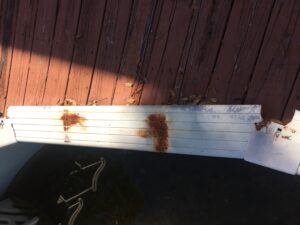
Rusty top rails usually aren’t any cause for concern unless it’s severe. If it’s so rusty that there are jagged, sharp areas, then that can be dangerous to swimmers.
Most of the time though, rust on top rails just looks bad and people can live with that.
5 Rusty upright/s (vertical supports)
Some will get very concerned when they discover that one or two of their pool’s uprights are rusting through. This will not look good, but in most cases, the pool will be fine even if a couple of uprights are rusted completely in half.
They have just some structural value for the pool’s frame, but not much for the wall(which is what holds the water), so don’t be alarmed in that regard.
6 Rusty parts under the top rails
Under the top rails of an AG pool, there will be connector plates and top stabilizer bars. Regardless of what the top rails are made of, what’s under them can be made of steel or aluminum.
Sometimes a pool owner will notice some small pieces of rust in the pool and wonder where it’s coming from. Usually, the rust is flaking off of either the top connectors OR the stabilizer bars from under the top rails.
Taking a peek under the pool’s top rails from the outside of the pool will show if anything is rusting.
Rusty top connector plates and stabilizer bars can be annoying if flaking off into the pool water, but they don’t need to be addressed right away.
If these parts are becoming very rusty though, then they may have to be replaced when it’s time to change the liner in the pool as they all have to come off.
7 Surface rust at the inside of the pool’s wall
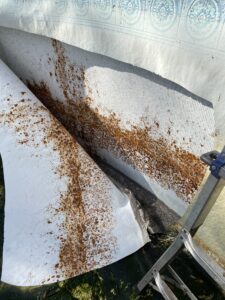
Usually, rust can only be identified inside of the wall when the liner is removed, which is usually during a liner changeout.
With this, some surface rust is ok and won’t hurt anything. If there is a lot of surface rust though, wall foam is recommended before installing the new liner.
This is a thin layer of foam glued onto the wall which will prevent the rust from touching the new liner anywhere.
8 Deep rust at the inside of the pool’s wall
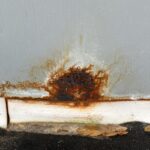
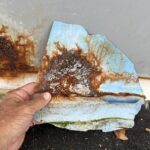

Again, usually discovered during a liner changeout, deep rust that is penetrating through the wall is cause for concern. Use a screwdriver or utility knife and poke the rusted areas to assess how deep the rust is or if it has rusted completely through the wall.
Rust on the walls that is penetrating deep into the metal is a major issue. One that is usually the cause for a total pool replacement.
WHAT CAUSES RUST ON ABOVE-GROUND POOLS?
When mixing metal with moisture, you’re going to have corrosion. So, swimming pools with metal parts that are outside have a high likelihood of corroding.
Not all above-ground pool rust though. In my now 38 years of working with them, I have seen many pools that are 10, 15, and even 20 years old with not a piece of rust. Most will rust some though with little issue.
Here in Orlando and Central Florida, we get morning dew. Dew makes everything outside a little wet in the morning. Then when that Florida sun comes up, it heats and dries everything back out. This can happen 200 days a year or more in Central Florida.
Dew isn’t an issue with above-ground pools because everything dries completely in a couple of hours. So, it’s when moisture stays on metal pool parts for extended periods of time that will cause corrosion or rust. Like if the pool has a leak for example.
A small leak in your above-ground pool may be no be deal to you (especially during the Orlando summer when it rains every day), but allowing it to continue may be keeping the metal wall wet in an area for too long.
Prolonged exposure to wetness can eventually cause the protective coatings of metal pool parts to break down or lift which exposes the metal to moisture. Then rust begins.
TREATING RUSTY PARTS OF AN ABOVE-GROUND POOL
When some have rust on their pool’s top rails, they will take them off, sand them down, and then paint them with some form of anti-rust coating (like Rustoleum).
This usually will make the top rails look better for a while, but eventually, the rust comes back. Usually, rust comes back sooner than later for all parts that pool owners try to protect. Most will feel it wasn’t worth all that sanding and painting as it didn’t buy them much time.
Some will go through the big job of sanding down all the surface rust on the inside wall of their AG pool, Then they coat it with different things. Most just use Rustoleum paint and others will spend a lot on a fancier anti-corrosion chemical, then paint.
With the inside of pool walls, treating the rusted walls do rarely any good at all (except give good exercise to those who sanded them down). The corrosion almost always continues right after a new liner goes in and the pool is filled and back in use.
So, for rusted parts of an above-ground pool, I recommend either living with them (if they aren’t too bad) or seeing if you can find replacement parts and replace them.
NOTE: Sometimes you can replace metal top connectors and stabilizer bars with resin-made ones. Will-bar made pools do offer this on a couple of models.
If your pool wall (on the inside) has only surface rust, then I recommend buying and using wall foam when the time comes to change the liner. This will protect the new liner from being damaged by the surface rust
And if your pool’s wall is rusted completely through, you may be able to repair it with a partial wall replacement, but that is expensive, and hard to find someone who can do it correctly. More than likely, Replacing the entire pool is the way to go if the area is rusted through low and more than a couple of inches wide.
WHEN A RUSTED ABOVE-GROUND POOL NEEDS TO BE REPLACED
There are four main reasons that you may want to replace your AG pool due to rust/corrosion.
A The wall is rusted through
With an above-ground pool, it’s the wall that holds all of that water in place. The entire pool frame can be rusted, broken, or even removed, the pool will stay up.
A little rust hole towards the bottom of the wall though, and the pool can split open sending thousands of gallons of water into the yard and killing the pool.
Rusted-through pool walls should be addressed quickly as it can be a dangerous situation. In many cases, replacing the entire pool is the best answer.
B Rusting top rails are a danger to swimmers
The top rails of an above-ground pool are where swimmers will grab onto while using the pool or use them to get in or out of the water.
Rusted and jagged top rails can pose a threat to swimmers by cutting them when they grab on. Not cool.
When you can’t find replacement top rails (for your model) or it’s too expensive to do so, then replacing the pool is the best option.
C Pieces of rust are falling into the water
When top connectors, stabilizer bars, or even top rails are severely rusted, small pieces of rust will come off and fall into the pool. This can be a pain to constantly clean up. Also, sharp rusty pieces can cause holes in aged liners or can poke into swimmer’s feet.
If replacement parts cannot be found or it’s too expensive to replace them all, then the best option often is replacing the entire pool.
D The pool looks ugly
Some just get tired of looking at the rust on their pool and elect to replace it. In many cases, it needs replacing anyway.
